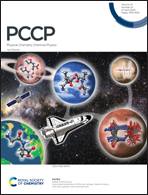Chirality of a rhodamine heterodimer linked to a DNA scaffold: an experimental and computational study†
Abstract
The chiroptical properties of multi-chromophoric systems are governed by the intermolecular arrangement of the monomeric units. We report on a computational and experimental study of the linear optical properties and supramolecular structure of a rhodamine heterodimer assembled on a DNA scaffold. The experimental absorption and circular dichroism (CD) profiles confirm the dimer formation. Computationally, starting from low-cost DFT/TDDFT simulations of the bare dimer we attribute the measured −/+ CD sign sequence of the S1/S2 bands to a specific chiral conformation of the heterodimer. In the monomers, as typical for rhodamine dyes, the electric transition dipole of the lowest π–π* transition is parallel to the long axis of the xanthene planes. We show that in the heterodimer the sign sequence of the two CD bands is related to the orientation of these long axes. To account explicitly for environment effects, we use molecular dynamics (MD) simulations for characterizing the supramolecular structure of the two optical isomers tethered on DNA. Average absorption and CD-profiles were modeled using ab initio TDDFT calculations at the geometries sampled along a few nanosecond MD run. The absorption profiles computed for both optical isomers are in good agreement with the experimental absorption spectrum and do not allow one to discriminate between them. The computed averaged CD profiles provide the orientation of monomers in the enantiomer that is dominant under the experimental conditions.



 Please wait while we load your content...
Please wait while we load your content...